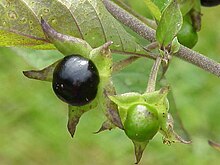Tropanole
Die Tropanole leiten sich vom Tropan ab, wobei eine Hydroxysubstitution am C-1, C-2- bzw. am C-3-Atom vorliegt. Für das 2- und das 3-Tropanol können zwei Stereoisomere unterschieden werden. Bei den α-Tropanolen steht die Hydroxygruppe axial, bei dem β-Tropanolen äquatorial zum Ringsystem.
| Tropanole | |||||
| Name | (1R)-1-Tropanol | 2α-Tropanol | 2β-Tropanol | 3α-Tropanol | 3β-Tropanol |
| Andere Namen |
|
|
|
|
|
| Strukturformel | 
|

|

|

|

|
| CAS-Nummer | 36127-54-5 | 36127-15-8 | 120-29-6 | 135-97-7 | |
| PubChem | 268139 | 54607705 | 8424 | ||
| Summenformel | C8H15NO | ||||
| Molare Masse | 141,21 g·mol−1 | ||||
| Schmelzpunkt | 47–48 °C oder 68–70 °C[1] | 46–48 °C[2] | −10 °C[3][4] | 63 °C[1] | 108–109 °C[1] |
| Siedepunkt | 94–95 °C[3][4] | 229 °C[1] | 240–241 °C[1] | ||
Eigenschaften
[Bearbeiten | Quelltext bearbeiten]Das (1R)-1-Tropanol steht mit (R)-(Methylamino)cycloheptanon in einem tautomeren Gleichgewicht.[1]
Vorkommen
[Bearbeiten | Quelltext bearbeiten]
Tropanole und davon abgeleitete Tropanalkaloide kommen in mehreren Pflanzenfamilien, insbesondere in den Nachtschattengewächsen (Solanaceen) vor. Zum Beispiel im Bilsenkraut (Hyoscyamus niger), in der Tollkirsche (Atropa belladonna) und in verschiedenen Stechapfel-Arten (Datura spec.). Das (1R)-1-Tropanol ist in der Andenbeere (Physalis peruviana) zu finden.[1] Ebenso findet sich im Echten Löffelkraut (Cochlearia officinalis, Brassicaceae) das Cochlearin mit Tropin als Alkoholkomponente. Die anderen Familien sind: Proteaceae, Convolvulaceae, Euphorbiaceae, Rhizophoraceae und Erythroxylaceae. Es konnte nachgewiesen werden, dass die Entwicklung der zur Biosynthese nötigen Enzyme in Nachtschatten- und Rotholzgewächsen unabhängig voneinander stattfand.[5]
Einzelnachweise
[Bearbeiten | Quelltext bearbeiten]- ↑ a b c d e f g Eintrag zu 3α-Tropanol. In: Römpp Online. Georg Thieme Verlag, abgerufen am 29. Januar 2013.
- ↑ S. Sarel, E. Dykman: Hypoiodate-induced oxidative dimerization and functionalization of the tropane bicyclic system. In: Tetrahedron Lett. 17, 1976, S. 3725–3728, doi:10.1016/S0040-4039(00)93093-4.
- ↑ a b D. E. Ayer, G. Büchi, P. R. Warnhoff, D. M. White: The structure of dioscorine. In: Journal of the American Chemical Society 80, 1958, S. 6146–6146, doi:10.1021/ja01555a061.
- ↑ a b W. A. M. Davies et al.: 703. An alkaloid of Dioscorea hispida, Dennstedt. Part VI. Some investigations on the synthesis of tropan-2-one. In: Journal of the Chemical Society. 1960, S. 3504–3512, doi:10.1039/JR9600003504.
- ↑ J. Jirschitzka, G. W. Schmidt et al.: Plant tropane alkaloid biosynthesis evolved independently in the Solanaceae and Erythroxylaceae. In: Proceedings of the National Academy of Sciences of the United States of America. Band 109, Nummer 26, Juni 2012, S. 10304–10309. doi:10.1073/pnas.1200473109. PMID 22665766. PMC 3387132 (freier Volltext).
